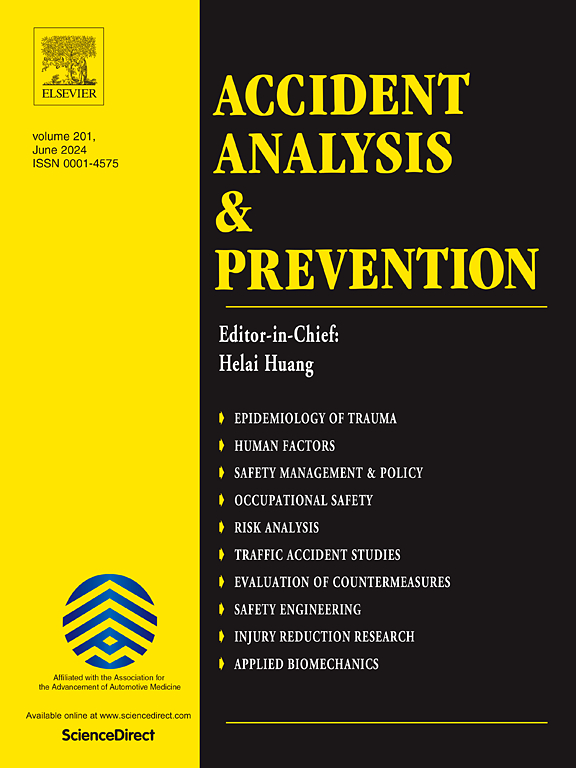Interpretable multi-variable transformer network for regional-level short-term bicycle crash risk prediction
IF 6.2
1区 工程技术
Q1 ERGONOMICS
引用次数: 0
Abstract
Effective short-term prediction of bicycle crashes at the urban regional level is critical for proactive infrastructure safety interventions and data-driven traffic management. However, three key challenges persist: (1) inadequate modeling of complex spatiotemporal dependencies in multi-source heterogeneous data; (2) poor handling of extreme class imbalance and lack of interpretability in deep learning-based short-term predictions; and (3) limited exploration of bicycle infrastructure’s role in regional crash risk assessment. In response to these challenges, we propose an Interpretable Multi-variable Transformer Network (IMTN) that employs four specialized Transformer encoder blocks to extract spatial and temporal dependencies from heterogeneous inputs. To mitigate the severe class imbalance, our approach uses a single, shared model to predict crash risk for one region at a time, rather than all regions simultaneously. This reformulation avoids data sparsity while retaining multi-region inputs, and a spatial weighting mechanism is used to preserve inter-regional dependencies. Meanwhile, an improved Layer-wise Relevance Propagation (LRP) framework is employed to enhance the interpretability of IMTN. We conduct our experiments on a four-year dataset from London, which includes crash records, public bicycle trips, time, weather, road networks, land use, and a rich set of 48 bicycle infrastructure features. The model comparison demonstrates that IMTN consistently outperforms competitive baselines, reducing false positive rate (FPR) by up to 9.08%, improving the area under the curve (AUC) by up to 3.49%, and increasing the G-mean by up to 5.39%. Our model achieves the best performance at the finest temporal resolution (1-hour aggregation), contrary to common expectations. This suggests that the proposed class imbalance handling method may enhance model performance in high-resolution settings. In addition, interpretability analysis identifies segregated cycle lanes, Sheffield stands, and colored path markings as high-impact infrastructure variables, providing data-driven insights that can help inform urban safety planning.
区域级短期自行车碰撞风险预测的可解释多变量变压器网络
在城市区域层面对自行车事故进行有效的短期预测对于主动的基础设施安全干预和数据驱动的交通管理至关重要。然而,存在三个关键挑战:(1)多源异构数据中复杂时空依赖关系的建模不足;(2)基于深度学习的短期预测对极端的类不平衡处理不力,缺乏可解释性;(3)自行车基础设施在区域碰撞风险评估中的作用探索有限。为了应对这些挑战,我们提出了一个可解释的多变量变压器网络(IMTN),它使用四个专门的变压器编码器块从异构输入中提取空间和时间依赖性。为了减轻严重的阶级不平衡,我们的方法使用一个单一的、共享的模型来预测一个地区的崩溃风险,而不是同时预测所有地区。这种重新表述在保留多区域输入的同时避免了数据稀疏性,并使用了空间加权机制来保持区域间的依赖性。同时,采用改进的分层关联传播(LRP)框架来提高IMTN的可解释性。我们在伦敦四年的数据集上进行实验,其中包括碰撞记录、公共自行车旅行、时间、天气、道路网络、土地使用以及一组丰富的48个自行车基础设施特征。模型比较表明,IMTN持续优于竞争基线,降低假阳性率(FPR)达9.08%,提高曲线下面积(AUC)达3.49%,提高g均值达5.39%。我们的模型在最佳时间分辨率(1小时聚合)下实现了最佳性能,这与通常的预期相反。这表明所提出的类不平衡处理方法可以提高模型在高分辨率设置下的性能。此外,可解释性分析将隔离的自行车道、谢菲尔德站和彩色道路标记识别为高影响的基础设施变量,提供数据驱动的见解,有助于为城市安全规划提供信息。
本文章由计算机程序翻译,如有差异,请以英文原文为准。
求助全文
约1分钟内获得全文
求助全文
来源期刊

Accident; analysis and prevention
Multiple-
CiteScore
11.90
自引率
16.90%
发文量
264
审稿时长
48 days
期刊介绍:
Accident Analysis & Prevention provides wide coverage of the general areas relating to accidental injury and damage, including the pre-injury and immediate post-injury phases. Published papers deal with medical, legal, economic, educational, behavioral, theoretical or empirical aspects of transportation accidents, as well as with accidents at other sites. Selected topics within the scope of the Journal may include: studies of human, environmental and vehicular factors influencing the occurrence, type and severity of accidents and injury; the design, implementation and evaluation of countermeasures; biomechanics of impact and human tolerance limits to injury; modelling and statistical analysis of accident data; policy, planning and decision-making in safety.
 求助内容:
求助内容: 应助结果提醒方式:
应助结果提醒方式:


